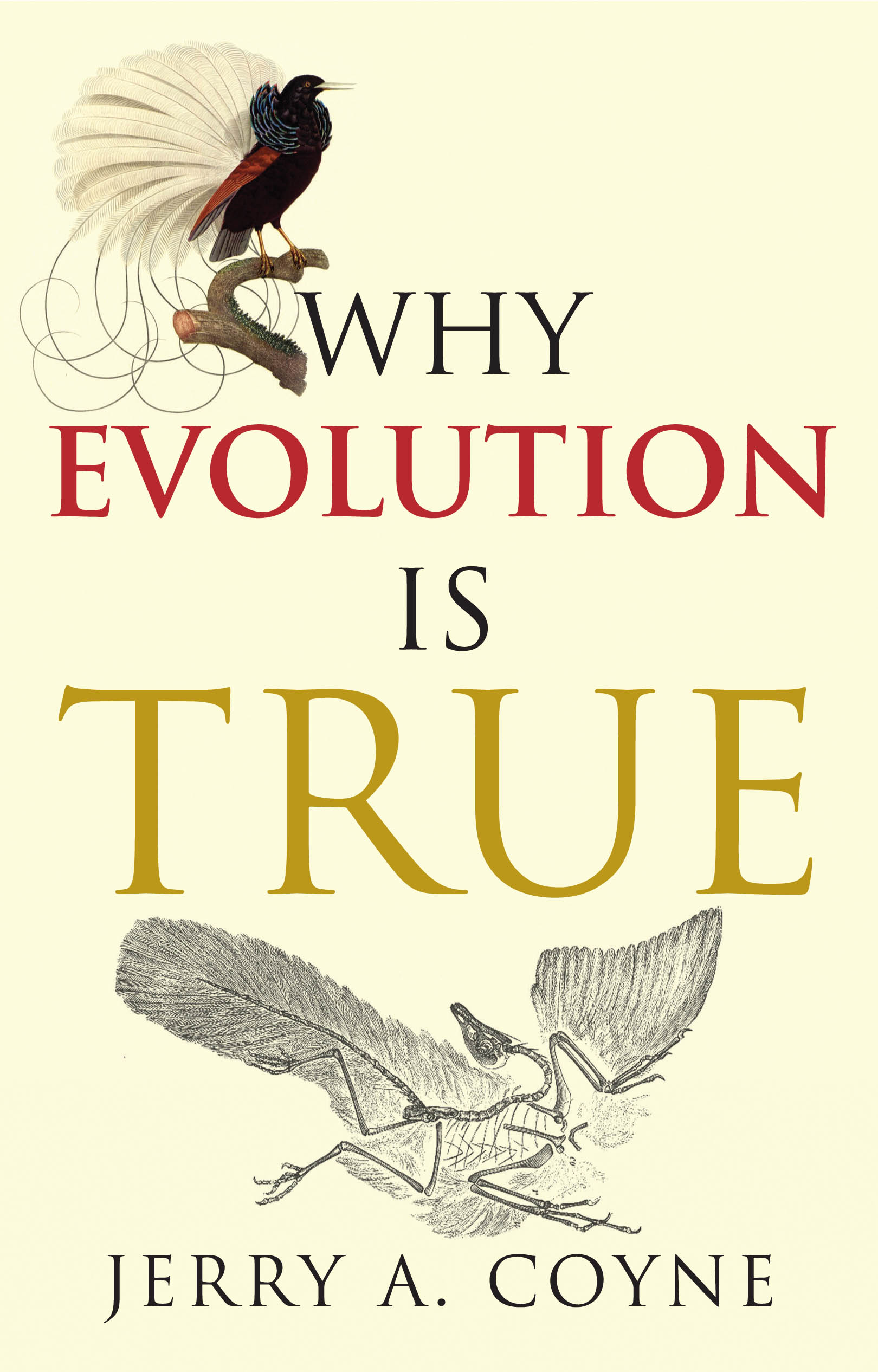 Jerry Coyne is a biologist who, among other things, studies fruit flies. His book Why Evolution is True is a very informative discussion of evolution for the non-scientist like me, or at least the science-minded non-scientist. He sets the theory of evolution against non-scientific creationism, which more recently is called the theory of intelligent design (ID), and contrasts what science has to offer with what intelligent design tries to convey.
Jerry Coyne is a biologist who, among other things, studies fruit flies. His book Why Evolution is True is a very informative discussion of evolution for the non-scientist like me, or at least the science-minded non-scientist. He sets the theory of evolution against non-scientific creationism, which more recently is called the theory of intelligent design (ID), and contrasts what science has to offer with what intelligent design tries to convey.
Because a theory is accepted as “true” only when its assertions and predictions are tested over and over again, and confirmed repeatedly, there is no one moment when a scientific theory suddenly becomes a scientific fact. A theory becomes a fact (or a “truth”) when so much evidence has accumulated in its favor— and there is no decisive evidence against it— that virtually all reasonable people will accept it. This does not mean that a “true” theory will never be falsified. All scientific truth is provisional, subject to modification in light of new evidence. There is no alarm bell that goes off to tell scientists that they’ve finally hit on the ultimate, unchangeable truths about nature. As we’ll see, it is possible that despite thousands of observations that support Darwinism, new data might show it to be wrong. I think this is unlikely, but scientists, unlike zealots, can’t afford to become arrogant about what they accept as true.
Coyne writes about a complex scientific subject for laymen to understand, and he conveys the concepts of evolution with masterful explanations. This could be a dry subject, but he makes it highly readable, a page-turner even.
One of the concepts he talks about is how nature sometimes comes up with very poor designs, so poor in fact, that an intelligent designer would never implement them. We all know about the appendix in humans, a dangerous organ without any apparent purpose, a liability to humans through the eons that killed as many as one in a hundred people until surgery was developed only very recently. I myself had acute appendicitis at age 22 and I would not have survived as late as 100 years ago. The appendix can only be explained in evolutionary context and suddenly it makes sense.
The routing of the human vas deferens is another example of poor design. It shows that the testes in humans descended from the abdominal cavity to be outside the body, but the vas is routed over the ureter. When the testicles descended, they did so on the wrong side of the ureter, causing a detour.
One glaring example is the laryngeal nerve in all mammals. This nerve connects to brain to the larynx, but it is routed from the brain down into the chest cavity first, wrapping around the aorta, before going up to the larynx. This does not seem such a big deal for humans, but it’s also the case on long-necked mammals like in giraffes, where the nerve is over fifteen feet longer than it would have to be to connect the brain to the larynx. Here is Coyne:
One of nature’s worst designs is shown by the recurrent laryngeal nerve of mammals. Running from the brain to the larynx, this nerve helps us speak and swallow. The curious thing is that it is much longer than it needs to be. Rather than taking a direct route from the brain to the larynx, a distance of about a foot in humans, the nerve runs down into our chest, loops around the aorta and a ligament derived from an artery, and then travels back up (“ recurs”) to connect to the larynx (figure 19). It winds up being three feet long. In giraffes the nerve takes a similar path, but one that runs all the way down that long neck and back up again: a distance fifteen feet longer than the direct route! When I first heard about this strange nerve, I had trouble believing it. Wanting to see for myself, I mustered up my courage to make a trip to the human anatomy lab and inspect my first corpse. An obliging professor showed me the nerve, tracing its course with a pencil down the torso and back up to the throat.
This circuitous path of the recurrent laryngeal nerve is not only poor design, but might even be maladaptive. That extra length makes it more prone to injury. It can, for example, be damaged by a blow to the chest, making it hard to talk or swallow. But the pathway makes sense when we understand how the recurrent laryngeal nerve evolved. Like the mammalian aorta itself, it descends from those branchial arches of our fishlike ancestors. In the early fishlike embryos of all vertebrates, the nerve runs from top to bottom alongside the blood vessel of the sixth branchial arch; it is a branch of the larger vagus nerve that travels along the back from the brain. And in adult fish, the nerve remains in that position, connecting the brain to the gills and helping them pump water.
We humans make ourselves way too important. Our last split from our closest relatives on the evolutionary tree are the chimpanzees. We split from a common ancestor about seven million years ago. Many dozens of human species evolved and have become extinct since, except for the Cro Magnon that was the last precursor of the modern homo sapiens. Modern man arose around 6,000 years ago when the ancient Egyptian dynasties flourished. In evolutionary scales we have not really changed since then. There is no appreciable difference between ancient Egyptians, ancient Greeks, Romans, medieval Europeans and modern Americans. If we dressed an ancient Egyptian in a business suit and taught him English, he could function in our society, drive a car and use an iPad, in no time. Modern man is about 250 generations old. Man is some 300,000 generations old. For 300,000 generations, lasting millions of years, our ancestors worried about predators, disease, constantly had to hunt for food and secure water, and were lucky if they lived to age 30. For 300,000 generations this was life, without much change. Until agriculture developed and the first civilizations were built about 6,000 years ago.
In Why Evolution is True, Coyne leads the reader through the history of organisms in our world, and explains how the incredible diversity and richness of nature that we experience every day came about.
Everything just makes common sense.
Rating: ***
